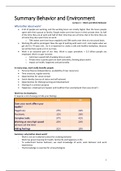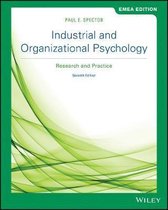Summary Behavior and Environment
Lecture 1 – Work and Work Behavior
Why bother about work?
• A lot of people are working, and the working hours are mostly higher than the hours people
spent with their spouse or family. People make over time hours in their private time. So half
of the time they are at work and half of their time they are at home. But in the time they are
at home they also spent time on work.
o 70% makes over time hours regularly and 30% works over time at a structural basis.
• Working life will be prolonged. Now the age of quitting with work is 67, and maybe when we
get old it is 70 years old… So it is important to create a safe and healthy workplace, because
we will be there quite a lot in our lives.
• Work is an essential part of our lives. Work is super prevalent: > 3.5 billion people are
employed. Work is super invasive:
o Full-timers spend half of waking time on work
o Private time is partly spent on work (overtime, thinking about work)
o Impact on health, happiness and personality
In many ways, work really benefits people
• Personal finance (independence, availability of new resources)
• Time structure, regular activity
• Opportunities for social contact
• Social identity (source of status and self-esteem)
• Opportunities for lifelong learning and development
• Sharing of a common purpose
• Happiness: employed are happier and healthier than unemployed (‘two way street’)
Work has its drawbacks:
It requires a lot of energy to hide your feelings.
Summary: why bother about work?
- Work is not an incidental context for studying behavior
- Work has great meaning for health, family life and happiness in life
- To understand human behavior, we need knowledge of work, work behavior and work
experiences
- That knowledge is essential for all psychologists
1
,The scope is dynamic
In 1913 there were whole factories that were doing just one thing (for example: making cars, or sorting
envelops, etc.). At the moment the buildings are very diverse, you can do different things within one
building. In the future you will see workplaces with a lot of space and windows. The workplaces will be
very open, but you can question if the privacy is still there.
Societal dynamics
Organisations these days are operating in a very different field than 20 or 40 years ago. This had to do
with the free market, a global economy, companies in the business all over the world 24 hours a day 7
days a week. They should in order to survive in strong international competition. On an organizational
level you see that organisations nowadays need much more:
• Flexibility in order to be able to respond to these rapidly changing environmental demands.
Flexibility in terms of personnel, working times, employability of personal staff, structure (the
flatter the organisations the more flexible they will be able to operate, strong hierarchic
organisations vary rigid), strategic level (focusing on core business: having a lean, production
lines, always searching for possibilities on strategic, structural and operational level to be as
flexible as possible because the environment is so rapidly changing. Also be very careful with
their costs, must be productive, high quality, innovative all the time. This has results for people
on the work floor. Feeling the pressure of being the best.
• Intensification: On an individual level work is getting more complex and intensive (because of
technology and taking out all the simple and routine based tasks, so the complex tasks are left
for the personnel). Only intensive tasks after intensive tasks.
• Mentalisation: there was a huge shift from working in factories or in agricultures to working
with your mind (knowledge). This was a strong development during the last 20-30 years.
• Digitalisation: it is important for all the workers to keep up with all technological skills to keep
up with their work to prevent burnouts.
• Prolonged working life:
primarily economic reason
why we have to work longer:
this has to do with the fact that
too many people are getting
older and when everyone
would retire at 65, we could
not anymore afford all the
pension benefits. The life
expectancy is rising and is
pictured below.
What about healthy life
expectancy?
It is not rising to a similar
extent, if at all (it looks rather
stable). It is strongly related to
educational level (no gender
differences). Highly educated
people live more healthy, more
exercise. People with higher
education are getting to work
years later than people with a lower education, so with lower education you have a longer exposure
to work. The quality of work is lower in jobs for people with lower education, so they suffer more than
highly educated people in their jobs.
2
,What does W&O psychology involve?
Core question: How can W&O psychology contribute towards helping people work in a motivated,
productive and healthy way during their entire working life?
• W&O psychology = Work (and Health) psychology + Organisational psychology
Work (and Health) psychology
How should work, work conditions and work and resting times be structured in order to guarantee
work quality and good health, and to optimise performance?
Job design, fatigue, stress, motivation, sickness absence.
Organisational psychology
How should organisations and business processes be structured to make people collaborate as
efficiently and effectively as possible?
Organisational structure & culture, leadership, organisational change, dealing with resistance.
Personnel (HR) psychology
How can we ensure an optimal P-E fit in which individual capacities and desires (continue to) match
work demands and opportunities within the organisation?
Recruitment & selection, development of competences, performance appraisal, (financial) reward
systems.
History of W&O psychology
• W&O psychology is nearly as old as psychology itself. 1892: opening of first psychological
laboratory in the Netherlands.
• Founding father of experimental psychology: Wilhelm Wundt. → opening first psychology lab
in Leipzig.
3
, • Münsterberg was very well respected and a pupil of Wundt. During the World War I he lost a
bit of respect and defended the German actions in the first world war and didn’t got him
credits in America.
• Taylor saw that workers acted lazy and didn’t work efficiently. He used time & motion studies
to carefully map the work activities and separating them in different actions and movements
and try to find out which movement would be most effective to do a certain action. Using a
stopwatch and disentangled these actions in different movements. At the end he was able to
improve productivity by 400% in this shovel industry. → scientific management.
• Frank & Lillian Gilbreth: time & motion studies (he was an engineer and she was a
psychologist). More from a human perspective (wellbeing of workers what Taylor didn’t
include in his time & motion studies). Four principles Scientific Management (1911):
o Scientific approach.
o Select the right worker for the job (the one who could make the movements the most
quickly and efficiently).
o The training and development of the worker was based on these movements and
simple actions.
o Separation of head and hand work (the managers are there to think and the workers
to work).
• In practice: the worker was
an extension of the machine.
So they were not taken
seriously and it were no
human conditions to work in.
Workers were exploited.
Protest from labour unions.
→ US Congress investigation
→ stopwatch forbidden in
public sector.
• Modern forms of Scientific
Management: in McDonalds,
Call centres, Ryanair.
Taylorism is alive and well!
Till World War I and after
The first assembly line (= lopende
band) → Ford Motor Company
(1913).
• Man is extension of machine
• Standard products → T-Ford
• Mass production
• No right to labour unions
• Ford ‘gestapo’ and culture of
fear
4






